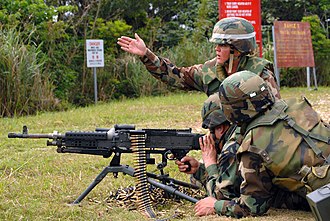Tripod
A tripod is a portable three-legged frame or stand, used as a platform for supporting the weight and maintaining the stability of some other object. The three-legged (triangular stance) design provides good stability against gravitational loads as well as horizontal shear forces, and better leverage for resisting tipping over due to lateral forces can be achieved by spreading the legs away from the vertical centre. Variations with one, two, and four legs are termed monopod, bipod, and quadripod (similar to a table).
Etymology
Template:Special characters First attested in English in the early 17th century, the word tripod comes via Latin tripodis (GEN of tripus),<ref>Template:L&S</ref><ref>Harper, Douglas. "tripod". Online Etymology Dictionary.</ref> which is the romanization of Greek τρίπους (tripous), "three-footed" (GEN τρίποδος, tripodos),<ref>τρίπους. Liddell, Henry George; Scott, Robert; A Greek–English Lexicon at the Perseus Project</ref> ultimately from τρι- (tri-), "three times"<ref>τρι- in Liddell and Scott.</ref> (from τρία, tria, "three")<ref>τρία in Liddell and Scott.</ref> + πούς (pous), "foot".<ref>πούς in Liddell and Scott.</ref> The earliest attested form of the word is the Mycenaean Greek 𐀴𐀪𐀠, ti-ri-po, written in Linear B syllabic script.<ref>ti-ri-po is found on the PY Ta 641 and PY Ta 709 tablets. 𐀴𐀪𐀠𐀆, ti-ri-po-de (found on the PY Ta 641 tablet), is the NOM dual form of the word. "The Linear B word ti-ri-po-de". Palaeolexicon. Word study tool of ancient languages. Raymoure, K.A. "ti-ri-po". Minoan Linear A & Mycenaean Linear B. Deaditerranean. "PY 641 Ta (2)". "PY 709 Ta (2)". DĀMOS: Database of Mycenaean at Oslo. University of Oslo.</ref>
Cultural use

Many cultures, including the ancient peoples of China and Greece, used tripods as ornaments, trophies, sacrificial altars, cooking vessels or cauldrons, and decorative ceramic pottery. Tripod pottery have been part of the archaeological assemblage in China since the earliest Neolithic cultures of Cishan and Peiligang in the 7th and 8th millennium BC.<ref>Stark, Miriam T. (2006). Archaeology of Asia. Blackwell Publishing. p. 44. ISBN 978-1-4051-0213-1.</ref> Sacrificial tripods were found in use in ancient China usually cast in bronze but sometimes appearing in ceramic form.<ref name="EBERHARD">Wolfram, Eberhard. A History of China. Berkeley and Los Angeles: University of California Press, 3rd edition, 1969. Cf. p.49 for illustration of Ancient bronze tripod found at Anyang.</ref> They are often referred to as "dings" and usually have three legs, but in some usages have four legs.
The Chinese use sacrificial tripods symbolically in modern times, such as in 2005, when a "National Unity Tripod" made of bronze was presented by the central Chinese government to the government of northwest China's Xinjiang Uygur Autonomous Region to mark its fiftieth birthday. It was described as a traditional Chinese sacrificial vessel symbolizing unity.<ref>"National Unity Tripod presented to mark Xinjiang's 50th birthday". China: People's Daily. October 1, 2005.</ref>
In ancient Greece, tripods were frequently used to support lebes, or cauldrons, sometimes for cooking and other uses such as supporting vases.
Firearms

Tripods are commonly used on machine guns to provide a stable mount for the weapon when firing.<ref name="army study guide tripod">"M122 Tripod". Army Study Guide. Archived from the original on 11 May 2021. Retrieved 25 June 2022.</ref>
Tripods are generally restricted to heavier weapons where the weight would be an encumbrance. For lighter weapons such as rifles, a bipod is more common. However, in recent times tripod saddles have become popular for precision rifle shooting sports, with the weapon placed in a vise-like rest which is mounted to a tripod head<ref name="hog saddle interrview">Zant, Cal (26 March 2014). "Shooting Rest: HOG Saddle & PIG Saddle Review". Precision Rifle Blog. Archived from the original on 21 June 2021. Retrieved 25 June 2022.</ref><ref name="sniper central hog saddle">Ewing, Melvin (30 August 2021). "Other Product Review HOG SADDLE – FULL REVIEW". Sniper Central. Archived from the original on 30 August 2021. Retrieved 25 June 2022.</ref> or with the weapon mounted directly to the tripod head.
Photography
Surveying
Astronomy
The astronomical tripod is a sturdy three-leg stand used to support telescopes or binoculars, though they may also be used to support attached cameras or ancillary equipment. The astronomical tripod is normally fitted with an altazimuth or equatorial mount to assist in tracking celestial bodies.<ref>"Telescope and Tripod". Universe Today. 21 May 2008.</ref><ref>Rotoni, Vito (23 May 2003). "Telescope Support Stand System: Background of the Invention". U.S. Patent and Trademark Office 7048238. Archived from the original on 2 April 2011. Retrieved 27 August 2009.</ref>
Laboratory

See also
- ISO 1222 (tripod screw mount)
- Trivet
- Triskelion
References
External links
 The dictionary definition of tripod at Wiktionary
The dictionary definition of tripod at Wiktionary Media related to Lua error in Module:Commons_link at line 63: attempt to index field 'wikibase' (a nil value). at Wikimedia Commons
Media related to Lua error in Module:Commons_link at line 63: attempt to index field 'wikibase' (a nil value). at Wikimedia Commons- Complete information of tripods